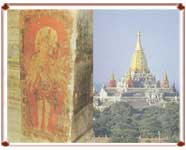Historic Area of Bagan, Myanmar
© UNESCO 1998
National implementing agency : Department of Archaeology
Project duration: 1994 - 1996
Total project cost: US$ 283,400
With more than 2800 monuments from the tenth to the fourteenth centuries concentrated on a single site (some 80 km2), Bagan, is one of the major historical landmarks of Asia. By their range of sizes, diversity of styles and decorative elements contrasting with marked conceptual and technological unity, these monuments represent the outstanding artistic and technical achievement of an original and innovative Buddhist school of art.
The last two decades have witnessed the rapid deterioration of certain structures. In addition, the earthquake of 1975 caused severe damage to many monuments. The three successive UNESCO/UNDP projects were carried out for institutional building, some experimental conservation work and restoration of selected mural paintings.
Under the Japanese Trust Fund project, a master plan for the preservation of Bagan was prepared principally by Professor Yukio NISHIMURA of the University of Tokyo, to propose guidelines for cultural heritage protection in harmony with development activities. The master plan includes plans for the protection of the historical area, for the conservation and restoration of the monuments, and for cultural tourism and economic development.
(Extract from "Preservation of Cultural Heritage through the UNESCO/Japanese Trust Fund" p.17)
Links:
Latest Publication on the International Cooperation through the UNESCO/Japanese Funds-in-Trust (
pdf, 2.91MB)
Second publication (2003) concerning the Japanese Funds-in-Trust Preservation of Cultural Heritage (
pdf, 2.29MB)
First publication concerning the Japanese Funds-in-Trust Preservation of Cultural Heritage (1998) (
pdf, 5.92MB)
Back to : The Japanese Funds-in-trust for the Preservation of World Cultural Heritage
Legal Matters | About Accessibility | Privacy Policy
Copyright : 2013 Permanent Delegation of Japan to UNESCO
